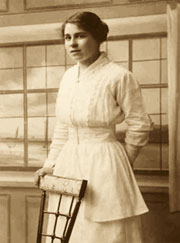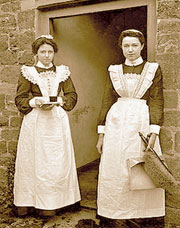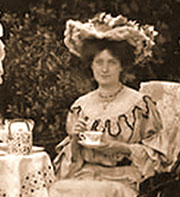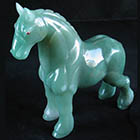Here are some images of my favorite hardstone, Faberge-like animals from my collections with stories about how they were created and why
Serving Dinner, Russian Fashion
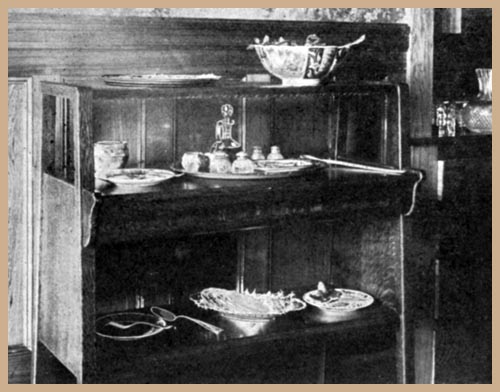 Above: Side Table, showing use in removing articles after serving Salad Course
Above: Side Table, showing use in removing articles after serving Salad Course
Dinner being a formal meal, we select it as the one best adapted to illustrate the Russian manner of serving; i. e.y from the side. This is not only the most elegant, but the simplest style of service, for the waitress, or other attendants, pass everything. When it is desired to serve dinner from the table (English style), follow out the general plan given in the preceding paper for serving breakfast, making only such changes as are needed to adapt the service to the required meal. Directions for serving soup from the table are given at the close of this chapter.
 LAYING THE DINNER-TABLE FOR RUSSIAN SERVICE
LAYING THE DINNER-TABLE FOR RUSSIAN SERVICE
Lay the table according to the directions given in preceding chapter on English service until it comes to the arranging of the "covers".
For these use a plate of dinner size. Place a dinner knife at the right of the plate, cutting edge towards the plate, and beyond this, the spoon for soup. This may be a table or dessert spoon, or a round-bowled soup spoon. If raw oysters or clams are to be served, lay an oyster fork across the soup spoon, or beyond it, to the right. When canapes take the place of oysters, a small fork takes the place of the oyster fork. On the left dispose the forks in order of use, just as on the right, the utensil to be used first being farthest from the plate; as, fork for fish, entree, and roast. This array of cutlery being quite enough to occupy the space allotted to a cover, forks for additional entrees, and the forks and spoons needed for the dessert service, are usually passed when needed. At the left of the forks lay the napkin, a roll or piece of bread between the folds but in sight. Occasionally we see a roll laid on the top of the napkin, but a partial covering with the napkin is preferable. Near the point of the dinner knife set the glass for water, and beside this the glass for Apolli-naris or charged water. Or, if wine be served, the glass for water is set nearly in front of the plate, the glass for sauterne at the tip of the soup spoon, and that for sherry between the three, forming a half circle. Back of these, forming a second half circle, with the sauterne glass as the first in the circle, place the glasses for champagne and Burgundy, to accompany the roast and game, respectively.
Place salt and pepper cups and spoons, or shakers, between each two covers. The floral decorations, and the candelabra or candlesticks, placed symmetrically upon the table, complete the laying of the table. We will suppose that the table is laid for six covers, and that the following menu is to be served by one waitress. No wine is included in the menu.
REPRESENTATIVE DINNER MENU
Oysters. Brown-bread Sandwiches.
Consomme. Pulled Bread. Olives. Celery.
Baked Turbans of Fish. Potato Diamonds with Peas.
Cucumber Salad.
Sweetbread-and-Mushroom Croquettes, Asparagus Tips.
Roast Turkey. Cranberry Jelly.
Mashed Potato.
Fried Egg Plant.
Roman Punch.
Broiled Fillets of Venison.
Red Currant Jelly in Rice Cups.
Chicory Salad.
Macedoine of Fruit in Jelly (Individual Moulds)
Whipped Cream.
Bonbons. Salted Almonds.
Coffee.
With everything ready beforehand, a well-trained waitress, seconded by a cook with whom she works harmoniously, can serve this meal with ease and celerity. With a larger number of covers an extra maid in the pantry to clear away the dishes, or in the dining-room, to follow the waitress with the accessories of the dish she is serving as the pulled bread, olives, and celery served with soup will tend to smoother and shorter service.
ANNOUNCING THE DINNER
The oysters on the deep shell, lying on plates of crushed ice with a quarter of a lemon in the centre of each plate, are in place upon the service plate at each cover, and the glasses are filled with water, when the waitress, stepping to the entrance of the room where the guests are assembled, says, "Dinner is served." When all are seated, she passes the brown-bread sandwiches to the left of each in turn, beginning on the right or left of the host, at pleasure. This course finished, the plates are removed from the right, one at a time, beginning with the one first served. These plates, as are all soiled plates, are deposited in the pantry. When more than two maids are in attendance, the oysters are brought in and the glasses filled with water after the guests are seated.
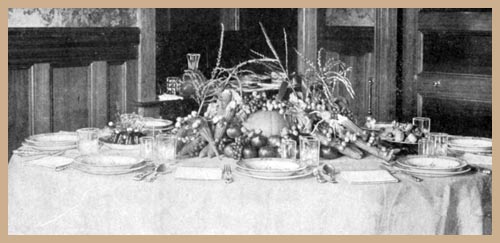 Above: Table laid for Thanksgiving Dinner, Russian Style of Service
Above: Table laid for Thanksgiving Dinner, Russian Style of Service
SERVING THE SOUP
The waitress now brings in two plates of soup, one in each hand. The plate in her left hand is set down upon the serving-table, the other is set down upon the service plate of the guest sitting on the side of the host opposite the one served first with sandwiches. The second plate of soup, brought from the serving-table, is set down, from the right, before the guest next in order. Two more plates of soup are brought in as before, and this routine is repeated until all are served in order, the host being served last. The pulled bread, olives, and celery are now passed upon a tray to the left of the one first served with soup, who helps herself to what she wishes. The service or place plate now comes into use as the receptacle upon which these articles are placed. At discretion, the bread may be passed first, and be followed by the celery and olives, together, on the tray.
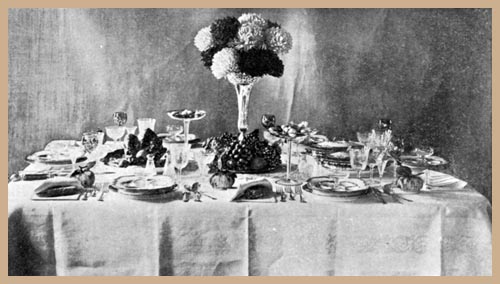 Above: Table laid for Thanksgiving Dinner, English Style of Service
Above: Table laid for Thanksgiving Dinner, English Style of Service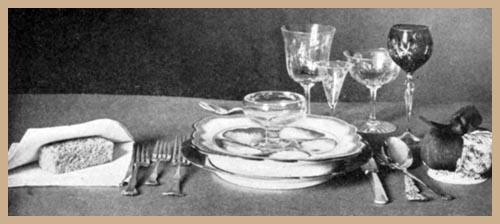
Above: Detail of Cover of Dinner Table, laid English Style
SIDE AT WHICH DISHES ARE SET DOWN AND PRESENTED
Note that dishes are set down and removed from the right of the individual served, and that dishes from which one is to help himself are presented at the left hand. The reason for this is obvious, when one tries to reverse the procedure. When presenting a dish hold it low enough to enable the guest to help himself with ease.
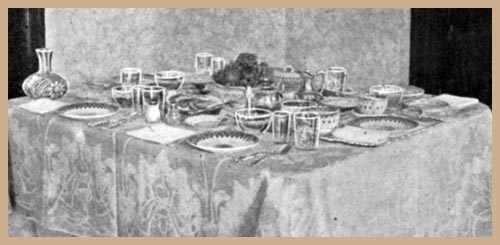 Above: Table laid for breakfast, English Style, showing First, or Fruit Course
Above: Table laid for breakfast, English Style, showing First, or Fruit Course
REMOVING THE SOUP PLATES
When this course is finished, step to the right of the one first served, take up the soup plate, leaving the other plate in position, and carry it to the pantry. Continue in order until all are removed.
SERVING THE FISH (1st)
The fish may be served in one of two ways: First, the "turbans" may be disposed on a large platter with the sauce around it, the whole handsomely decorated, and the diamonds of potato upon another platter, neatly garnished with parsley. Carry a warm plate (or one in each hand) from the serving-table to the guest at the right or left of the host, and continue in order; then carry the platter offish, on a folded napkin laid on the flat of the hand, to the right of the one first supplied with a plate. Place a turban of fish and sauce upon the plate. Repeat until all are served. Then serve the potato diamonds in the same manner.
SERVING THE FISH (2d)
Have the fish plates prepared in the pantry, a turban of fish with sauce and diamond of potato on each. Bring two plates from the pantry; set one upon the serving-table, and carry the other to the first individual to be served, and set it down from the right upon the place plate. Return for the second plate, and, when this is set in place, bring in two more plates prepared as before, and so continue in order until all are served with this course. In ideal service, with several maids in attendance, but one plate is carried at a time. When two plates, one in each hand, are brought from the pantry, set the one in the left hand on the side-table, then transfer the one in the right hand to the left hand before setting it down before the guest.
SERVING THE CUCUMBERS
Bring six chilled plates of small size to the serving-table. Set one of these plates to the right of the glass of water at each cover, beginning with the guest to whom fish was first served. Then, carrying the salad bowl, with a spoon in the bowl, on a folded napkin laid on the flat of the left hand, go to the right of each guest, and dispose half a dozen slices of cucumber and a little dressing upon each plate. If any guest signifies that salad is not desired, pass quietly on. The cucumbers are eaten with the fish fork.
A separate fork is not necessarily provided for a salad served with fish, roast, or game. It is always supplied for salad served as a separate course. Remove the cucumber plates first, one at a time or one in each hand.
SERVING THE ENTREE
The entree of croquettes with asparagus tips may be disposed on individual plates, and set down with the right hand upon the service plate as the fish is taken up with the left hand. The retention of the service plate gives opportunity to eat the celery or olives that may still be upon this plate. If preferred, empty plates may be set down as the fish plate is taken up; ..and, when those are all in place, the croquettes, surrounded with the asparagus, may be carried to the right of each guest upon the flat of the hand, and thus be served from a large and handsomely gotten up dish.
SERVING THE TURKEY AND VEGETABLES
Bring in two dinner plates holding turkey. Leave one on the serving-table. Then, going to the right or left of the host (begin the courses, alternately, on the right and left), take up the service plate with the croquette plate upon it and set down the plate of turkey. Continue in order, exchanging the service and croquette plates for the dinner plate until all have been served with turkey. Bring in the dish of potato a spoon pressed down into it on the flat of the left hand, a folded napkin between the dish and hand. Go to the right of each in order, beginning with the first one served to turkey, and place a "helping" of potato on the plate. Serve the giblet sauce, egg plant, and cranberry jelly in the order given and in the same manner, noting quickly the quietly spoken disinclination of a guest to be served to any dish. Now, if needed, pass bread or rolls to the left for each to help himself, and fill the glasses with water. While waiting for this course to be finished, you may lay above the plate a fork or spoon for the Roman punch. As in all cases where an article is set down, not passed, set the spoons in place from the right of the guests. Punch is frequently served with the roast rather than as a course by itself. When served by itself, in ideal service, the fork or spoon with which it is to be eaten, if not set in place when the table was laid, should be brought in on the tray with the glass of punch and laid upon the cloth beside the glass.
SERVING THE PUNCH
When the main course of the dinner is finished, bring in two glasses of punch on small plates covered with doilies. Leave one on the serving-table, and carry the other to the guest at the left of the host. Use a tray, if spoons for the punch are brought in at this time. If the guest on the right was served first to the first course, take up the dinner plate with the left hand, and set down the punch with the right hand and from the right. Repeat until all are served.
SERVING THE GAME COURSE
When the punch has been disposed of, in the same manner as before, serving first the guest at the right of the host, replace the plates holding the punch glasses with plates upon which the venison and rice cups with jelly are disposed. When all are served, set small plates, one at a time, for those wishing salad. These plates may hold the salad when brought to the table or the salad may be placed upon the plates after each has been set in its proper place. When this course is finished, remove the salad plates, two side by side on a tray or one at a time without the tray. Then remove the game plates, always one at a time, and in the same order in which they were brought in.
With a tray take up salt and pepper boxes; and, when these have been disposed of, return and free the table from crumbs.
SERVING THE SWEET COURSE
Have the moulds of jelly and fruit with cream decoration ready on individual plates. Set these, one at a time, before each guest, at the right. Bring in the finger-bowls on small doily-covered plates, one at a time, and take out the dessert plate. After all are provided with these, the bowl and doily being removed from the plate, pass the bonbons and nuts on a tray to the left of each, that each may help himself. The almonds may have been passed before, as they are in order at any time, when there is delay in serving a course. Bread is passed and glasses are filled with water whenever needed. Coffee in cups is now brought in and set down as usual from the right, and cream and sugar on a tray are afterwards passed to the left of each guest.
When the main dish of the dessert is not shaped in individual portions, but a portion is to be cut for each individual, the finger-bowis may be brought in upon the dessert plates with a doily between. These plates suffice also for the bonbons.
SERVING SOUP AT DINNER, ENGLISH STYLE
The directions given for serving breakfast after the English fashion can easily be modified to suit the serving of dinner. At the hour appointed for dinner, let the waitress ascertain if the family be ready for the meal. If so, give the final touches to the table, /. e.y bring in the butter and fill the glasses with water; bring the soup plates, comfortably heated, to the serving-table, and set the soup tureen, covered, before the place designed for the hostess; remove the cover of the tureen, reverse it, to avoid drops of water (condensed steam),and take it on the tray to the side-table or pantry. Bring back two soup plates; set one down to be supplied with soup, then take up the filled plate and set down the other. Set the plate of soup on the service plate of the one for whom it was prepared and take another plate from the side-table to set down on taking up the second filled plate, and thus continue.
RE-FILLING WATER GLASES
Whatever be the style of service, the waitress should look after the re-filling of the glasses at the end of every course.Glases should be re-filled from the right side, and the water or other beverage ought whenever possible to be poured into the glass as it stands on the table, without moving it from its place.When this is inconvenient, the waitress should remember that the glass is never to be lifted, but drawn a little way along the cloth towards her; and in doing this her fingers should not touch the body of the glass - the place where the fingers of the guest naturally hold it - but only the extreme lower part.Where a tumbler is used, the waitress's fingers touch the thicker glass at the botom; with a goblet two fingers press the flat standard and the goblet is moved a little way without touching either the stem or the cup.
RULES FOR REMOVING FROM INDIVIDUAL COVERS
The old rule was that all removing should be done from the right.This, because most of the articles composing the cover could be more conveniently taken away from this side.But with the introduction of the plate for bread and butter, the half-moon shaped plate for the salad to accompany the game course, it became evident that this should be removed from the left, otherwise the waitress should stretch across the guest - an inexcusable act.It is therefore admittedly correct that articles may be removed from either side.But wherever possible, the waitress should in removing use the hand wich corresponds to side of the guest at wich she stands.This rule should be considered invariable except where the waitress is obliged to remove with the one hand the dish used in any course and with the other hand to place a dish for the next course.In such a case she removes with the left hand, and places the fresh dish with the right.
